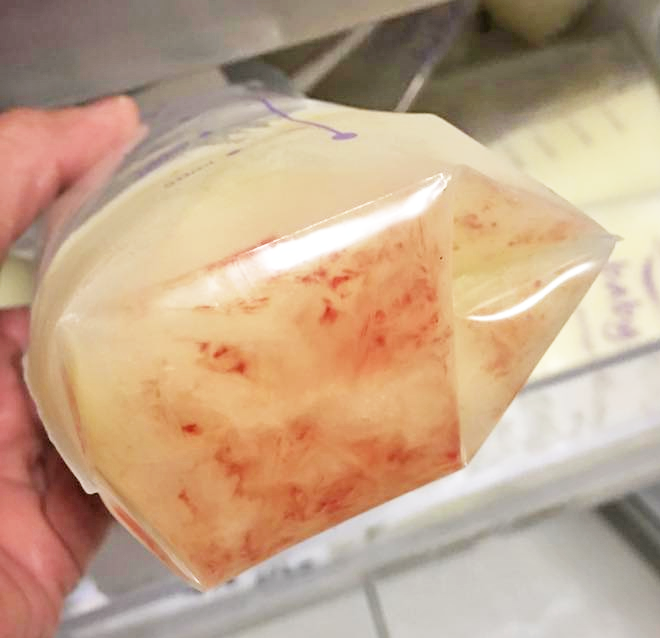
Ever noticed a pinkish tinge to your expressed breast milk – or spotted blood in bub’s spit-up after a feed? Turns out, finding blood in your breast milk happens more often than you think.
I was checking my milk stash in the freezer and saw bits of red in my frozen expressed breast milk. It’s just on the bottom of the bag, the rest seems normal. Could it be blood? My son had a tongue tie at the time which made breastfeeding painful. Should I just chuck it?
– Isabelle, Winter 2022 baby group
We speak with expert lactation consultant Lynne-McKensey Hall to find out the five main causes of blood in breast milk, and what we can do about it.
1. ‘Rusty pipe syndrome’
There are a number of reasons why you may see blood in your expressed breast milk. In the early days after birth regardless of whether you hand express or breastfeed, you may notice blood in the colostrum or milk you express or in your baby’s ‘spit ups.’ This is generally a sign of ‘rusty pipe syndrome.’ which occurs from increased blood flow to your breasts as ductal and breast tissue grows and develops quickly as your milk comes in.
Some of that residual blood in the ducts may leak into the colostrum giving it a rusty coloured appearance. Not everyone experiences this ‘rusty pipe’ syndrome. It’s painless and generally seen in the first few breastfeeds or ‘expressing ‘after birth. The colour of the ‘spit up’ or expressed colostrum can be tinged a darkish reddish, chocolate brown with occasional flecks of pink to brighter red blood.
Be reassured this is normal and generally disappears within the first week of breastfeeding or ongoing expressing. You should be encouraged to keep breastfeeding your baby with no interventions needed at this time.
2. Damaged nipples
If you have not been shown how to hand express or use a breast pump properly you can cause initial and ongoing damage to your breasts or nipples. Overzealous hand expressing while breast compressing or using strong pressure causing pain or pinching close to the nipples can also cause tissue damage and bleeding that transfers into the colostrum or the milk you are expressing.
You may need to continue expressing with an electric pump if you have a premature baby who can’t breastfeed or, it has been suggested you use a pump to rest your bleeding and damaged nipples from incorrectly attaching your baby to the breast. You will continue to see blood in the milk while you express if there is pain and discomfort while you’re using the pump.
You may think (or have been told) that turning the vacuum up high on an electric pump will produce more milk. Instead, your breast tissue is being pressured and damaged causing capillaries and small blood vessels in the breast tissue and milk ducts to bleed. Nipples will also become damaged and bleed into the pump container if the breast shield over the nipple is too tight or held too close to the side of the nipple. Turn down the vacuum to reduce the pressure on the ducts and breast tissue. Reposition the breast shield to see if that resolves the pain. If it doesn’t you may need larger breast shields.
3. Intraductal papilloma
You may see blood while expressing from an intraductal papilloma, a small benign growth on the milk duct lining that bleeds into your container. This ongoing and painless bleeding from the nipples should be checked to eliminate cancer or any other cause.
4. Mastitis
Unresolved mastitis can put pressure on breast tissue causing blood to leak through the milk ducts and colour your expressed milk. You can keep expressing and giving the milk to your baby even if you are on antibiotics compatible with breastfeeding.
5. Bacteria
A specific bacterium, Serratia marsescens can grow from inadequate cleaning and storage of your pumping equipment. This can infect your breasts, make the expressed milk red and potentially make your baby sick. Stop feeding your baby this milk and see your doctor who will probably culture the milk and commence you on antibiotics. You can continue to express but discard your milk until the infection clears when you can resume expressing again as you need or want to.

Can I give my baby ‘bloody’ breast milk?

Generally, you can continue giving your baby your expressed milk as you resolve the issues causing the bleeding. It’s worth freezing your blood-tinged or strawberry-coloured milk to help improve the taste, which may be better tolerated by your baby than fresh blood-tinged or coloured expressed milk. Worth a try!
You should always seek medical advice for any bleeding that continues in spite of your improved expressing techniques. It’s also worthwhile contacting a lactation consultant for ongoing help and support.
Read next …
- Q&A: How much milk does a newborn need?
- Q&A: Can I get a tattoo while breastfeeding?
- Q&A: Do I take my own breast pump to hospital?




